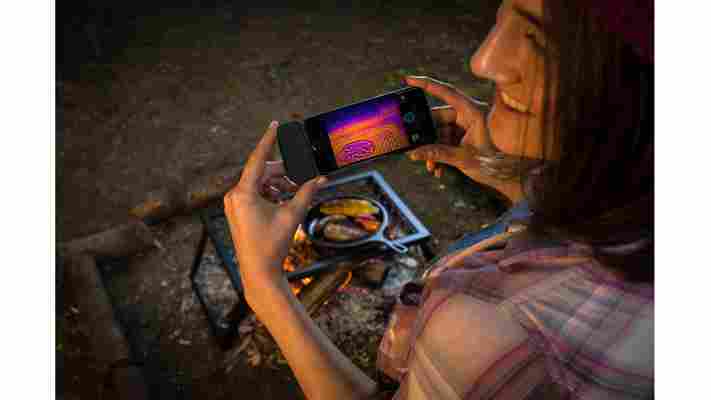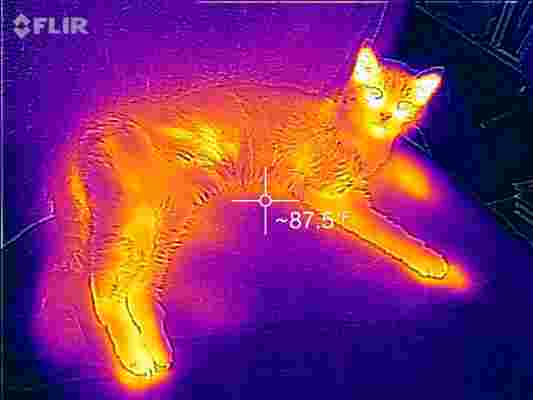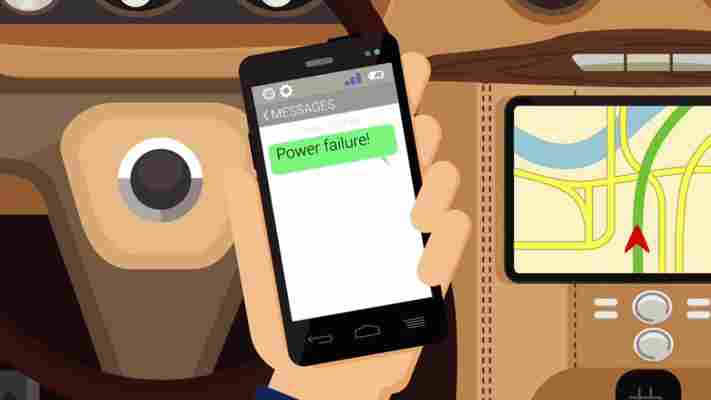Flir One , a thermal imaging camera attachment to your iPhone or Android smartphone, is designed to let you peer deep into impenetrable places like walls and through the pitch black darkness of night. For this utilitarian purpose alone, contractors, sportspeople and homeowners will likely put the $250 Flir to work in more ways than they would have imagined.

While this device won’t let you see through walls, it detects and lets you visualize the heat of objects behind them via its Flir One Companion app. That app’s psychedelic color schemes have also caught the attention of visual artists, some (not all) of whom would not know a dry wall from a circuit board. Creative folks are crafting Flir’s unique visions into vibrant artworks.
I had a look at the second-generation Flir One in both homeowner and artist mode and found it was equally able to detect a potential clogged drain (and make it look as pretty as a drain could look) as heat escaping through my windows, while at the same time producing extremely decorative images of whatever I would normally photograph, though at 640 x 480 resolution.


The new second generation Flir has a much different form factor and includes a more powerful thermal sensor than the original camera , with four times the resolution for crisper and clearer images. As a detachable accessory that fits into the lightening or microUSB connector of your mobile device, it is also lighter — less than one-third the weight of the original — at 2.75 ounces.
Thermal imaging camera
The human eye can see only a small part of the electromagnetic spectrum. Flir’s cameras, on the other hand — like the Seek Thermal and Fluke cameras — can see into the infrared spectrum, which is comprised of longer wavelengths than visible light. And that is what allows the device’s camera to see heat in the same way as humans see light, and show you the results.
Flir’s dime-sized Lepton camera, with its long-wave infrared sensor, converts heat into color images, allows us to see even fine gradations in temperature, which may be critical in detecting leaks, seeing prowlers or finding a lost pet in the darkness — even through fog and smoke. It detects temperature differences as small as 0.18 degrees F (0.1 degrees C).
Flir One tech
Flir One employs both a standard camera and a thermal camera. Its technology is designed to emboss a visible image onto the thermal image without eliminating thermal information — while enhancing the resolution and detail of the image.
MSX blending technology adds visible spectrum detail to thermal images and enhances resolution. It is designed to dramatically increase your ability to interpret a thermal image in real-world environments by adding visible edge detail to it.
Flir One works off of its own battery and does not drain the one in your device. When inactive, FLIR automatically switches to low-power mode to maximize battery life. I found a fully charged battery worked for several days on and off without a recharge.
The Lightning connector is reversible, so iOS users can plug the unit into their device facing either forward or backward, depending on what you want to see.
Thermal camera app
The hardware works in conjunction with the free Flir One app for iOS and Android which has an intuitive interface and a variety of functions that let you capture, save, and share its images both for utilitarian and entertainment value.
As the official companion app for the device, you will need to have it launched in order to see the thermal images. Artists will revel in nine color palettes, including Iron, Gray, Rainbow, Contrast, Arctic, Lava, Wheel, Coldest, Hottest. Features include Panorama, TimeLapse and CloseUp.
There are several other apps you can also use with the Flir One, as the company’s SDK allows third-party apps to take advantage of the thermal sensor. Flir’s own Flir Tools , a cross-platform app available both for desktop and mobile , lets you view images taken with the thermal camera and apply various parameters to compile analyses and reports or to zoom in for close-ups and different views of the images.
Downsides
Because Flir is an attachment that fits onto your device body, the most obvious downside is that not all covers will allow the device a proper fit.
Tapping on the screen flips the image rather than enlarges it. Also the software does not allow the iPhone volume to act as a shutter, forcing you to use the on-screen button.
If you’re going to use Flir for artistic imaging, it would be nice if the software made it easy to remove the Flir watermark from your images.
Bottom line
Flir One Second Generation is a valuable tool for checking potential problems at home and can detect very small gradations in temperature. It was able to identify hot spots around my refrigerator and windows while giving me the thumbs up on my circuit breaker and plumbing.
The improved camera can give an artistic look to images, regardless of whether they were taken for home improvement or recreation.
Flir One is available for $249.99. All companion apps, except for Zombie Vision , are free.
➤ Flir One
Ceco Home keeps your smart home connected, even if the Wi-Fi and power go down
Each week we’re profiling one company that has been selected for Boost – our early-stage startup growth program. Catch up with these companies in person at The Next Web Conference in Amsterdam on May 26-27.

The ‘smart home’ has made great strides forward in recent years, but there are still basic problems that can leave you in two minds about embracing the Internet of Things.
What if there’s a power cut? What if your Wi-Fi goes down ? Will your home keep working as it should? Ceco Home from Finland’s iSocket Systems could allay these fears. It’s a connected home monitoring system that uses 3G to communicate with the outside world.
Plug a Ceco Home device into a power socket in your home and it will act as a unified messaging platform for your Thread -compatible Internet of Things devices. Here’s how it works
Ceco Home promotional video
Ahead of iSocket Systems’ participation in our Boost program at TNW Conference Europe 2016 in May, we asked the company’s CEO, Denis Sokol, to tell us more…
Tell us what you do in two sentences.
We send prompt and reliable notifications about problems in users’ homes – this is what we do.
How did the company come about? What’s your background?
I have been an entrepreneur all my life. I created my first IT company at the age of 21 and sold it soon after I moved to Finland eight years ago.
One day in 2008 I wanted to be informed when the power failed in my cottage – to be able to act immediately and avoid pipes freezing in the house in the winter. I also wanted to turn on extra heating remotely.
I could not find any solution for either of these problems, especially not an elegant solution, like a simple ‘plug and play’ socket. So I decided to design my own. I sold my previous business and focused on the new project.
Thus, in 2010 we introduced a new term to the world – ‘Smart Socket.’ We called the plug iSocket – we reckoned they were “intelligent sockets”. Folks call them Smart Plugs now. There are plenty of smart plugs on the market now: Belkin WeMo , D-Link , etc. Smart Plugs are a new class of equipment now – a new category. But who created this trend or this category? Well… actually we did.
We started slowly – very slowly. No exhibitions, no Boost programs, no contests, no social activity, and no VCs. I hadn’t even registered the entity and it was entrepreneurial activity. I thought I could do it all with my own money and I didn’t want to invite anyone to whom I would have to report. Actually, I knew nothing about VCs until 2015. I was just enjoying creating new products and seeing these raise interest among people all over the world.
Thus, for almost five years all we were doing was just selling hardware – different models of iSockets and sensors to solve different customers’ problems: reporting power failures, water leaks, gas leaks, break-ins, temperature changes, etc.
We had almost got going when, suddenly… Aliexpress – everyone could buy a piece of hardware for cents, distributors were not interested in volume anymore, and plenty of WiFi plugs become available on the market. In 2014 I decided: 1) we have to go directly to customers, 2) we must build a service around our hardware. This was my first discovery – a bit late, but better later than never.
Then… I haven’t mentioned yet that our iSockets are cellular. Otherwise how else would you get a reliable alert? Or how could you get an alert at all if Wi-Fi fails? Or if power fails? Or how could you reboot your Wi-Fi router? We were focused on cellular technology to deliver prompt notifications.
We began when Wi-Fi was not common in homes. Now that Wi-Fi has become the standard for internet connection in today’s home, I believe that it will not be the standard for a smart home and I also believe that the cellular network will continue to play an important role in the IoT, particularly in smart homes. I found that telcos now have a lot of problems as IoT becomes more popular. And the biggest problem is – they are simply losing their customers, because customers are no longer loyal.
In 2015 I decided: we should address these problems since we are in the smart home market and we have extensive experience in cellular technology.
The next thing I noticed is that the DIY market was gaining traction – e.g. SmartThings, who didn’t actually offer really innovative products when they started their Kickstarter campaign, because the problem their products solved at that time had already been solved by our products – include water leaks. But the really new thing they offered was a kind of ecosystem for developers. If you analyze their campaign, you will see that many pledges were for features for developers. This was a definite signal for me. This was my third discovery.
Around about the same time I met Thread – the new, I would say revolutionary, protocol for smart homes from such companies as Nest, Samsung, and Yale. That was so well timed! Thread was created for connecting things inside the home in a really smart, innovative, secure way with the motto “no single point of failure.”
http://youtu.be/0v95t3jtktI
Thread Group promotional video
Well, things are connected, but how to get them out online to the Internet? Via Wi-Fi? What if Wi-Fi fails or power fails? You can’t get in touch with your home. This is the failure for consumers – never mind what engineers call things. I decided: we must join the Thread Group and we must address this problem too, because we know how to do it. This was my last discovery. I decided to join via the Thread Group’s Innovating Program and we won!
Having analyzed all these factors I decided to create a new market of Cellular Connected Homes and create an ecosystem for that. I called this ecosystem Ceco Home. I believe we become startup with this new project in 2015 again. While this ecosystem partly consists of previous products, it is in fact the new project.
This new ecosystem will be interesting for all players on IoT market: consumers, developers, telecom providers, DIY enthusiasts, and business customers too. The Ceco Home ecosystem has already been declared the winner of the Innovation Enabler Program by the Thread Group among hundreds of candidates and was chosen to be the finalists of the IOT / M2M Innovation World Cup 2015/16 among 400 candidates from 58 countries – and we hope to get more nominations and awards in the future.
Our main goal now is to gather community and we hope that Boost Program and TNW Conference will provide us a really good opportunity for that.
Who are your biggest rivals, and why are you different?
If we talk about products, most smart home companies, include biggest rivals such as SmartThings or Iris have components that they call devices for smart homes that are all similar. Most smart home and IoT companies are focused on Wi-Fi and have similar reliability and security flaws. We have developed a new global self-monitoring ecosystem that allows everyone to build an ultra-reliable, secure Smart Home that operates on any mobile network worldwide. Ceco can be used in an area where Internet is not provided. Most systems, except Nest, are still confusing when it comes to configuration. Ceco is simple.
But I wouldn’t consider these companies to be competitors – I would prefer to cooperate with them. For example, our solution can be a cellular backup for Nest or SmartThings homes. For our “Thread with Cellular” solution there are actually no direct competitors yet – that’s the new market. For most players, cellular is a backup. For us cellular is the ‘main ingredient.’ That, I would say, is the main difference in the products. Well, US Cellular offer a cellular connected home in USA, but locked to their network in one relatively small region. Ceco ecosystem allows everyone to build a reliable secure smart home that operates on any mobile network.
As a company with a background in hardware we can control every process from buying just a small resistor to the shipping of the final product to the customer. Hardware, software – all is in-house developing, we do not outsource. This allows us to understand the solution we offer very well and offer quick and quality backup support to our customers. I think that make a big difference nowadays when companies must offer more than just a product to the customer.
How big is your team? Tell us one weird fact about a member of your team.
The team is small, but smart. We are team of six and we are international. I organized our working flow so that we can all work from our own base. That probably won’t work as we grow, but so far it has worked well and everyone – most importantly our customers – is satisfied.
When I need extra help on the assembly line, I just invite supplementary workers to our lab. I also expect to find new members for my team from the community that we will gather with help of TNW in Amsterdam.
Weird fact?… Hm… Well, one of the youngsters in our team does not have any profiles on any social network – no Facebook, no Twitter, no LinkedIn, etc. Does it get weirder than that? :)
If you weren’t working on this, what would you be doing?
I can’t imagine myself doing anything else. I like creating new things – I’m an engineer first. I would rather be creative and watch my work being appreciated – see it help others to solve their problems – this cannot be bought for any money. It gives me satisfaction! This is my passion.
➤ Ceco Home
Amazon.com features The Wirecutter travel column as an ‘experiment’
If you were a lucky Amazonom customer today, you may have seen something unusual when accessing the site: A feature story from The Wirecutter, a highly regarded product review site, called The Best Travel Gear For Your Next Journey — with a percentage of those items available right there on Amazon.

What’s up with that? Is Amazon now sponsoring independent editorial content directly on its portal? We caught up with Brian Lam, founder of The Wirecutter to get the 411.
Anyone familiar with The Wirecutter knows about its participation in Amazon’s affiliate program — and that most of the site’s revenue is derived from Amazon, as well as from other affiliates who pay The Wirecutter a commission for site referrals.
There is nothing special about the current publishing arrangement at all. According to Lam, it was all for the exposure — massive exposure in this case — and The Wirecutter got no special favors out of letting its story be published on Amazon’s site.
“ We use the same affiliate program everyone else does, and received no compensation or gave no compensation for the use of the content,” Lam told TNW.
“A ll the benefits are mutual and pretty obvious. Amazon customers get help finding gear that has been editorially vetted, collected and curated by The Wirecutter. And as an independent publication, it also gets exposure to new readers who we can help in the future,” Lam said.
This totally makes sense. Interestingly, it was Amazon that approached The Wirecutter for copy to use, and collaborated with the tech publication on presenting a story that was already in the works. “We suggested the [editorial] idea and they liked it. Then we continued to develop it on our own,” Lam said.
Will we see more from The Wirecutter on Amazon in the near future? Hard to say, but for now this collaboration is considered experimental.
“Our only plans are to continue to build a place with our friends that continues to help our readers and do it better and better as time goes on. It’s so much fun, and at the same time, we take the responsibility of helping people spend their hard-earned dollars very seriously.”
For the record, we also contacted Amazon to get its take on the decision to run Wirecutter copy, but since their team didn’t respond — and Brian did — we decided to go with the story now and then follow up later in case Amazon had additional information.
➤ The Wirecutter and Amazonom
